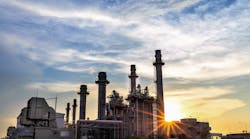The rising price of oil is generating new interest in oil exploration and production, as well as in the instrumentation used in this process. As a result, suppliers of such technologies as flowmeters, pressure transmitters, temperature sensors, valves, and analytical devices figure to see a boom in business over the next several years.
There are multiple rationales for the spike in oil prices, but the most fundamental reason is simple: increasing demand and diminishing long-term supply. Consumption by China and other developing countries is on the rise at a time when there is very little excess capacity in the system. Though oil companies have been slow to ramp up exploration and production in response to higher prices, this is more likely to occur as prices remain high. In late June, crude oil traded near the $60 per barrel level.
Regarding flowmeters specifically, the oil and gas exploration market breaks down as follows:
Differential pressure (DP) flowmeters remain a prominent fixture in many modern-day oil and gas production facilities. An inherently reliable technology, DP flowmeters are capable of lasting 10 or 20 years in the same application before replacement is needed. And while these meters may eventually be replaced, in many cases they will likely be replaced by other DP flowmeters rather than by newer technologies, simply because DP has proven to be a reliable choice.
Turbine flowmeter suppliers have made technology improvements in recent years by using more durable materials of construction, such as ceramic ball bearings, which has helped generate more appeal for oil and gas applications. In addition, turbine flowmeters are also widely used for flow measurement in utility applications. Gas utility companies use flowmeters to measure how much gas businesses, plants, and factories consume. Turbine meters compete to some extent with PD meters, although PD meters are typically used for lower flow applications, while turbine meters are used to measure higher speed flows.
Ultrasonic flowmeters are increasingly used for custody transfer of natural gas. To achieve the high accuracy required for custody transfer, ultrasonic meters use multiple paths (usually four, five, or six). Ultrasonic flowmeters are replacing DP and turbine flowmeters in some natural gas distribution lines, largely because they have no moving parts and require little maintenance and provide a wide rangeability for varying flowrates. Instromet (www.instromet.com) and Emerson Daniel (www.daniel.com) dominate this market, although FMC Measurement Solutions (www.fmctechnologies.com) also offers an ultrasonic flowmeter for custody transfer of natural gas.
Industry Approvals
One major factor that determines flowmeter uptake is industry approvals. The American Gas Association (AGA, www.aga.org) has issued reports outlining criteria for using DP, turbine, and ultrasonic flowmeters for gas flow measurement. The first report (AGA-3) was issued for orifice flowmeters. The report for turbine meters (AGA-7) was issued in 1996, and the report for multipath ultrasonic flowmeters was issued in 1998. Most recently, AGA published AGA-11, a report on the use of Coriolis flowmeters for measuring gas flow, which may signal an increase in Coriolis adoption for oil and gas applications.
Other Instrumentation
Oil and gas production is a highly complex process, which requires a variety of instrumentation beyond flowmeter technologies, all of which can expect to see an increase in demand as production facilities look to raise capacity levels.
For example, drilling rigs, pipes, pumps, separators, valves, and other technologies designed for oil and gas exploration and production are in good position to benefit from an industry-wide effort to meet increasing user demand.
In the short term, more exploration and production will lead to increased interest in products designed for drilling, processing, and distributing these valuable commodities. In the long term, the supply of oil and natural gas is diminishing. Alternative fuels, such as hydrogen, will be required in place of fossil fuels, which will likely lead to a boom in technological innovation on a whole new front.
Progress on alternative fuels has been slow to develop, and there has been little effort in the area of energy conservation, particularly in the United States. The influence of high oil prices is undeniable though, as there is growing support among users for conservation and research and development into alternative fuels. This should lead to a long-term trend toward new technology development for processing applications around alternative fuels.
About the Author
Jesse Yoder, Ph.D., is a regular contributor to Flow Control magazine. He has been a leading analyst in the process control industry since 1986. He specializes in flowmeters and other field devices, including pressure, level, and temperature products. Dr. Yoder has written 60 market research studies in industrial automation and process control and has published numerous journal articles. His latest study, The World Market for Gas Flow Measurement, covers eight of the most prominent flowmeter types in the gas measurement field. Currently, Dr. Yoder is the president of Flow Research Inc. He can be reached at [email protected] or 781 245-3200.
For More Information: www.flowresearch.com

